It is known that some varieties of wheat are sown in autumn but are harvested around next mid summer.
A.what could be the probable reason for this ?
B. what term is used for this promotion of flowering under low temperature?
C. which palnt hormone can replace the cold treatment?
A Annul winter wheat plants take one your full gorowng season for the completion of their vegativtive growth period and then intiate flower and fruts. This is because after they forms seedling in autumn , they receive low temperautre thoroughout winter ., which enables them to reach vegeative maturiry . They resime growth in spring and bear flower and grain stowards mid summer .
B.The chilling or cold treatemtnt of seeds to reduce flowering is called vernalisation .It is a propcess of shrotening of the juvenile of vegative p[hase and hastening flowsering by a previous cold treatment . This stimulus of venalisation is percieived only by thbe meristematic cells e.g shoot tip embryou tip root apex develpoing leaves etc .
C. GA or gibberellic acid treatement can replace cold treatment and can induce flowerin early by reducing vegetative growthh period in many loon day plants.
Topper's Solved these Questions
- PLANT GROWTH AND DEVELOPMENT BOOK - NCERT EXEMPLAR ENGLISHCHAPTER - PLANT GROWTH AND DEVELOPMENT EXERCISE - Short Answer Type Question
20 Videos
- PHOTOSYNTHESIS IN HIGHER PLANTSBOOK - NCERT EXEMPLAR ENGLISHCHAPTER - PHOTOSYNTHESIS IN HIGHER PLANTSEXERCISE - Long Answer type Question
13 Videos
- PLANT KINGDOMBOOK - NCERT EXEMPLAR ENGLISHCHAPTER - PLANT KINGDOMEXERCISE - LONG ANSWER TYPE QUSTIONS
5 Videos
Similar Questions
Fill in the blanks:
(1) Wheat, barley end rye have two kinds of varieties: winter and spring varieties. The ‘spring’ variety are normally planted in ....a.... and come to flower and produce grain before the end of growing season.
(2) 'Winter varieties, however if planned in ..b... would normally fail to flower or produce mature grain within a span of flowering season.
(3) hence ‘winter’ varieties are planted in ..c.... . They germinate, and over ........d come out as harvested usually around mid-summer.
View SolutionDark Snow
Most of Greenland’s interior is covered by a thick layer of ice and compressed snow known as the Greenland Ice Sheet. The size of the ice sheet fluctuates seasonally: in summer, average daily high temperatures in Greenland can rise to slightly above 50 degrees Fahrenheit, partially melting the ice, in the winter, the sheet thickens as additional snow falls, and average daily low temperatures can drop to (12) as low as 20 degrees–––––––––––––––––––––.
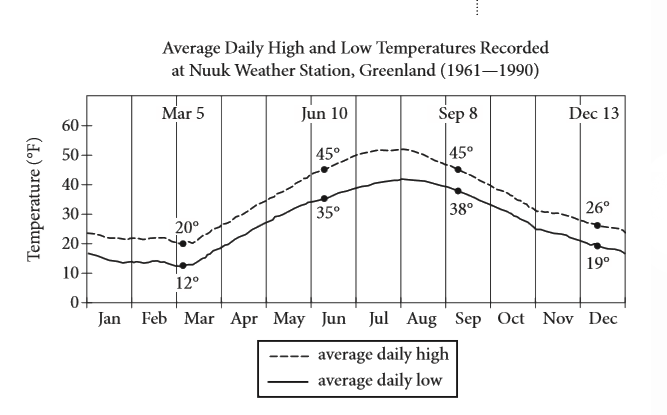
Typically, the ice sheet begins to show evidence of thawing in late (13)summer. This follows––––––––––––––––––––––– several weeks of higher temperatures. 14 For example––––––––––––––, in the summer of 2012, virtually the entire Greenland Ice Sheet underwent thawing at or near its surface by mid-July, the earliest date on record. Most scientists looking for the causes of the Great Melt of 2012 have focused exclusively on rising temperatures. The summer of 2012 was the warmest in 170 years, records show. But Jason (15) Box, an associate––––––––––––––––––– professor of geology at Ohio State believes that another factor added to the early (16) (thaw), the “dark snow” problem.
According to Box, a leading Greenland expert, tundra fires in 2012 from as far away as North America produced great amounts of soot, some (17) of it–––––drifted over Greenland in giant plumes of smoke and then (18) fell–––– as particles onto the ice sheet. Scientists have long known that soot particles facilitate melting by darkening snow and ice, limiting (19) it’s–––– ability to reflect the Sun’s rays. As Box explains, “Soot is an extremely powerful light absorber. It settles over the ice and captures the Sun’s heat.” The result is a self-reinforcing cycle. As the ice melts, the land and water under the ice become exposed, and since land and water are darker than snow, the surface absorbs even more heat, which (20) is related to the rising temperatures–––––––––––––––––––––––––––––––––––––––.
[1] Box’s research is important because the fires of 2012 may not be a one-time phenomenon. [2] According to scientists, rising Arctic temperatures are making northern latitudes greener and thus more fire prone.[3] The pattern Box observed in 2012 may repeat (21) itself again––––––––––––, with harmful effects on the Arctic ecosystem. [4] Box is currently organizing an expedition to gather this crucial information. [5] The next step for Box and his team is to travel to Greenland to perform direct sampling of the ice in order to determine just how much the soot is contributing to the melting of the ice sheet. [6] Members of the public will be able to track his team’s progress—and even help fund the expedition—through a website Box has created. (22)
View Solution
Knowledge Check
You Are Where You Say
Research on regional variations in English-language use has not only yielded answers to such life-altering questions a show people in different parts of the United States refer to carbonated beverages (“soda”? “pop”? “coke”?) it also illustrate show technology can change the very nature of research. While traditional, human-intensive data collection has all but disappeared in language studies, the explosion ofsocial media has open edne wave nues for investigation. [1] Perhaps the epitome of traditional methodology is the Dictionary of American Regional English, colloquially known as DARE. [2] Its fifth and final alphabetical volume—ending with “zydeco”— released in 2012, the dictionary represents decade so far duous work. [3] Overa six-year period from 1965 to 1970, university graduate students conducted inter views in morethan a thousand communities across the nation. [4] Their goal was to determine what names people used for such every day object sand concepts as a submarine sandwich.
(a “hero” in New York City but a “dagwood”in many parts of Minnesota, Iow a, and Colorado) and a heavy rainstorm(variously a “gullywasher,” “pour-down,” or “stumpmover”). [5] The work that dictionary founder Frederic G. Cassidy had expected to be finished by 1976 was not,in fact, completed in his life time. [6] The wait did not dampen enthusiasm among scholars. Scholars consider the work a signal achievement in linguistics. Not all research into regional English varieties requires such time, effort, and resources, however. Today’s researchers have foundth at the veritable army of trained volunteer straveling the country conducting face-to- face inter view scan sometimes be replaced by another army the vastarray of individuals volunteering details about their lives— and,in advertently, their language— through social media. Brice Russ of Ohio State University,for example, has employed software to sort through postings on one social media cite in search of particular words and phrases of interest as well as the location from which users are posting. From these data,
he was able, among other things, to confirm regional variations in people's terms for soft drinks. As the map shows. ,“soda” is comm only heard in the middle and western portions of the United States, “pop” is frequently used in many southern states, and “coke”ispre dominant in the north eastern and south west region sbutused else where as well. As interesting as Russ’s findings are, though, they’re true value lies in their reminder that the Internet is not merelya sophisticated tool for collecting data but is also itself a rich source of data

To improve the cohesion and flow of this paragraph, the writer wants to add the following sentence. Data gathering proved to be the quick part of the project. The sentence would most logically be placed afterAsentence 2Bsentence 3Csentence 4Dsentence 5Dark Snow
Most of Greenland’s interior is covered by a thick layer of ice and compressed snow known as the Greenland Ice Sheet. The size of the ice sheet fluctuates seasonally: in summer, average daily high temperatures in Greenland can rise to slightly above 50 degrees Fahrenheit, partially melting the ice, in the winter, the sheet thickens as additional snow falls, and average daily low temperatures can drop to (12) as low as 20 degrees–––––––––––––––––––––.
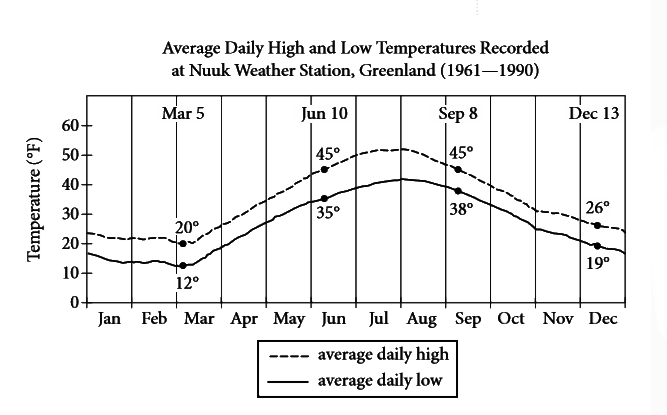
Typically, the ice sheet begins to show evidence of thawing in late (13)summer. This follows––––––––––––––––––––––– several weeks of higher temperatures. 14 For example––––––––––––––, in the summer of 2012, virtually the entire Greenland Ice Sheet underwent thawing at or near its surface by mid-July, the earliest date on record. Most scientists looking for the causes of the Great Melt of 2012 have focused exclusively on rising temperatures. The summer of 2012 was the warmest in 170 years, records show. But Jason (15) Box, an associate––––––––––––––––––– professor of geology at Ohio State believes that another factor added to the early (16) (thaw), the “dark snow” problem.
According to Box, a leading Greenland expert, tundra fires in 2012 from as far away as North America produced great amounts of soot, some (17) of it–––––drifted over Greenland in giant plumes of smoke and then (18) fell–––– as particles onto the ice sheet. Scientists have long known that soot particles facilitate melting by darkening snow and ice, limiting (19) it’s–––– ability to reflect the Sun’s rays. As Box explains, “Soot is an extremely powerful light absorber. It settles over the ice and captures the Sun’s heat.” The result is a self-reinforcing cycle. As the ice melts, the land and water under the ice become exposed, and since land and water are darker than snow, the surface absorbs even more heat, which (20) is related to the rising temperatures–––––––––––––––––––––––––––––––––––––––.
[1] Box’s research is important because the fires of 2012 may not be a one-time phenomenon. [2] According to scientists, rising Arctic temperatures are making northern latitudes greener and thus more fire prone.[3] The pattern Box observed in 2012 may repeat (21) itself again––––––––––––, with harmful effects on the Arctic ecosystem. [4] Box is currently organizing an expedition to gather this crucial information. [5] The next step for Box and his team is to travel to Greenland to perform direct sampling of the ice in order to determine just how much the soot is contributing to the melting of the ice sheet. [6] Members of the public will be able to track his team’s progress—and even help fund the expedition—through a website Box has created. (22)
13. Which choice most effectively combines the two sentences at the underlined portion?Asummer, followingBsummer, and this thawing followsCsummer, and such thawing followsDsummer and this evidence followsDark Snow
Most of Greenland’s interior is covered by a thick layer of ice and compressed snow known as the Greenland Ice Sheet. The size of the ice sheet fluctuates seasonally: in summer, average daily high temperatures in Greenland can rise to slightly above 50 degrees Fahrenheit, partially melting the ice, in the winter, the sheet thickens as additional snow falls, and average daily low temperatures can drop to (12) as low as 20 degrees–––––––––––––––––––––.

Typically, the ice sheet begins to show evidence of thawing in late (13)summer. This follows––––––––––––––––––––––– several weeks of higher temperatures. 14 For example––––––––––––––, in the summer of 2012, virtually the entire Greenland Ice Sheet underwent thawing at or near its surface by mid-July, the earliest date on record. Most scientists looking for the causes of the Great Melt of 2012 have focused exclusively on rising temperatures. The summer of 2012 was the warmest in 170 years, records show. But Jason (15) Box, an associate––––––––––––––––––– professor of geology at Ohio State believes that another factor added to the early (16) (thaw), the “dark snow” problem.
According to Box, a leading Greenland expert, tundra fires in 2012 from as far away as North America produced great amounts of soot, some (17) of it–––––drifted over Greenland in giant plumes of smoke and then (18) fell–––– as particles onto the ice sheet. Scientists have long known that soot particles facilitate melting by darkening snow and ice, limiting (19) it’s–––– ability to reflect the Sun’s rays. As Box explains, “Soot is an extremely powerful light absorber. It settles over the ice and captures the Sun’s heat.” The result is a self-reinforcing cycle. As the ice melts, the land and water under the ice become exposed, and since land and water are darker than snow, the surface absorbs even more heat, which (20) is related to the rising temperatures–––––––––––––––––––––––––––––––––––––––.
[1] Box’s research is important because the fires of 2012 may not be a one-time phenomenon. [2] According to scientists, rising Arctic temperatures are making northern latitudes greener and thus more fire prone.[3] The pattern Box observed in 2012 may repeat (21) itself again––––––––––––, with harmful effects on the Arctic ecosystem. [4] Box is currently organizing an expedition to gather this crucial information. [5] The next step for Box and his team is to travel to Greenland to perform direct sampling of the ice in order to determine just how much the soot is contributing to the melting of the ice sheet. [6] Members of the public will be able to track his team’s progress—and even help fund the expedition—through a website Box has created. (22)ANO CHANGEBHowever,CAs such,DMoreover,
Dark Snow
Most of Greenland’s interior is covered by a thick layer of ice and compressed snow known as the Greenland Ice Sheet. The size of the ice sheet fluctuates seasonally: in summer, average daily high temperatures in Greenland can rise to slightly above 50 degrees Fahrenheit, partially melting the ice, in the winter, the sheet thickens as additional snow falls, and average daily low temperatures can drop to (12) as low as 20 degrees–––––––––––––––––––––.
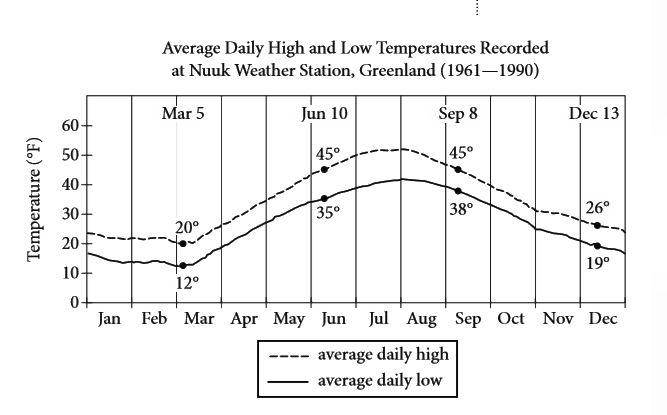
Typically, the ice sheet begins to show evidence of thawing in late (13)summer. This follows––––––––––––––––––––––– several weeks of higher temperatures. 14 For example––––––––––––––, in the summer of 2012, virtually the entire Greenland Ice Sheet underwent thawing at or near its surface by mid-July, the earliest date on record. Most scientists looking for the causes of the Great Melt of 2012 have focused exclusively on rising temperatures. The summer of 2012 was the warmest in 170 years, records show. But Jason (15) Box, an associate––––––––––––––––––– professor of geology at Ohio State believes that another factor added to the early (16) (thaw), the “dark snow” problem.
According to Box, a leading Greenland expert, tundra fires in 2012 from as far away as North America produced great amounts of soot, some (17) of it–––––drifted over Greenland in giant plumes of smoke and then (18) fell–––– as particles onto the ice sheet. Scientists have long known that soot particles facilitate melting by darkening snow and ice, limiting (19) it’s–––– ability to reflect the Sun’s rays. As Box explains, “Soot is an extremely powerful light absorber. It settles over the ice and captures the Sun’s heat.” The result is a self-reinforcing cycle. As the ice melts, the land and water under the ice become exposed, and since land and water are darker than snow, the surface absorbs even more heat, which (20) is related to the rising temperatures–––––––––––––––––––––––––––––––––––––––.
[1] Box’s research is important because the fires of 2012 may not be a one-time phenomenon. [2] According to scientists, rising Arctic temperatures are making northern latitudes greener and thus more fire prone.[3] The pattern Box observed in 2012 may repeat (21) itself again––––––––––––, with harmful effects on the Arctic ecosystem. [4] Box is currently organizing an expedition to gather this crucial information. [5] The next step for Box and his team is to travel to Greenland to perform direct sampling of the ice in order to determine just how much the soot is contributing to the melting of the ice sheet. [6] Members of the public will be able to track his team’s progress—and even help fund the expedition—through a website Box has created. (22)
12. Which choice most accurately and effectively represents the information in the graph?
View SolutionDark Snow
Most of Greenland’s interior is covered by a thick layer of ice and compressed snow known as the Greenland Ice Sheet. The size of the ice sheet fluctuates seasonally: in summer, average daily high temperatures in Greenland can rise to slightly above 50 degrees Fahrenheit, partially melting the ice, in the winter, the sheet thickens as additional snow falls, and average daily low temperatures can drop to (12) as low as 20 degrees–––––––––––––––––––––.
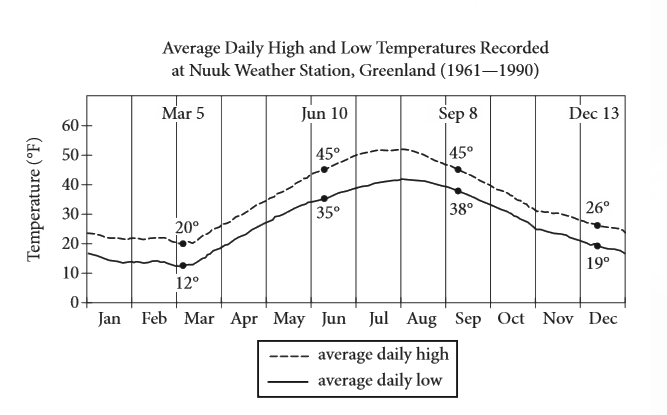
Typically, the ice sheet begins to show evidence of thawing in late (13)summer. This follows––––––––––––––––––––––– several weeks of higher temperatures. 14 For example––––––––––––––, in the summer of 2012, virtually the entire Greenland Ice Sheet underwent thawing at or near its surface by mid-July, the earliest date on record. Most scientists looking for the causes of the Great Melt of 2012 have focused exclusively on rising temperatures. The summer of 2012 was the warmest in 170 years, records show. But Jason (15) Box, an associate––––––––––––––––––– professor of geology at Ohio State believes that another factor added to the early (16) (thaw), the “dark snow” problem.
According to Box, a leading Greenland expert, tundra fires in 2012 from as far away as North America produced great amounts of soot, some (17) of it–––––drifted over Greenland in giant plumes of smoke and then (18) fell–––– as particles onto the ice sheet. Scientists have long known that soot particles facilitate melting by darkening snow and ice, limiting (19) it’s–––– ability to reflect the Sun’s rays. As Box explains, “Soot is an extremely powerful light absorber. It settles over the ice and captures the Sun’s heat.” The result is a self-reinforcing cycle. As the ice melts, the land and water under the ice become exposed, and since land and water are darker than snow, the surface absorbs even more heat, which (20) is related to the rising temperatures–––––––––––––––––––––––––––––––––––––––.
[1] Box’s research is important because the fires of 2012 may not be a one-time phenomenon. [2] According to scientists, rising Arctic temperatures are making northern latitudes greener and thus more fire prone.[3] The pattern Box observed in 2012 may repeat (21) itself again––––––––––––, with harmful effects on the Arctic ecosystem. [4] Box is currently organizing an expedition to gather this crucial information. [5] The next step for Box and his team is to travel to Greenland to perform direct sampling of the ice in order to determine just how much the soot is contributing to the melting of the ice sheet. [6] Members of the public will be able to track his team’s progress—and even help fund the expedition—through a website Box has created. (22)
View SolutionDark Snow
Most of Greenland’s interior is covered by a thick layer of ice and compressed snow known as the Greenland Ice Sheet. The size of the ice sheet fluctuates seasonally: in summer, average daily high temperatures in Greenland can rise to slightly above 50 degrees Fahrenheit, partially melting the ice, in the winter, the sheet thickens as additional snow falls, and average daily low temperatures can drop to (12) as low as 20 degrees–––––––––––––––––––––.
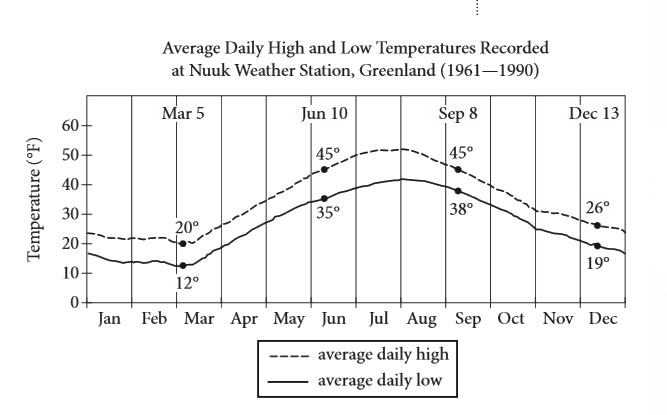
Typically, the ice sheet begins to show evidence of thawing in late (13)summer. This follows––––––––––––––––––––––– several weeks of higher temperatures. 14 For example––––––––––––––, in the summer of 2012, virtually the entire Greenland Ice Sheet underwent thawing at or near its surface by mid-July, the earliest date on record. Most scientists looking for the causes of the Great Melt of 2012 have focused exclusively on rising temperatures. The summer of 2012 was the warmest in 170 years, records show. But Jason (15) Box, an associate––––––––––––––––––– professor of geology at Ohio State believes that another factor added to the early (16) (thaw), the “dark snow” problem.
According to Box, a leading Greenland expert, tundra fires in 2012 from as far away as North America produced great amounts of soot, some (17) of it–––––drifted over Greenland in giant plumes of smoke and then (18) fell–––– as particles onto the ice sheet. Scientists have long known that soot particles facilitate melting by darkening snow and ice, limiting (19) it’s–––– ability to reflect the Sun’s rays. As Box explains, “Soot is an extremely powerful light absorber. It settles over the ice and captures the Sun’s heat.” The result is a self-reinforcing cycle. As the ice melts, the land and water under the ice become exposed, and since land and water are darker than snow, the surface absorbs even more heat, which (20) is related to the rising temperatures–––––––––––––––––––––––––––––––––––––––.
[1] Box’s research is important because the fires of 2012 may not be a one-time phenomenon. [2] According to scientists, rising Arctic temperatures are making northern latitudes greener and thus more fire prone.[3] The pattern Box observed in 2012 may repeat (21) itself again––––––––––––, with harmful effects on the Arctic ecosystem. [4] Box is currently organizing an expedition to gather this crucial information. [5] The next step for Box and his team is to travel to Greenland to perform direct sampling of the ice in order to determine just how much the soot is contributing to the melting of the ice sheet. [6] Members of the public will be able to track his team’s progress—and even help fund the expedition—through a website Box has created. (22)
View SolutionDark Snow
Most of Greenland’s interior is covered by a thick layer of ice and compressed snow known as the Greenland Ice Sheet. The size of the ice sheet fluctuates seasonally: in summer, average daily high temperatures in Greenland can rise to slightly above 50 degrees Fahrenheit, partially melting the ice, in the winter, the sheet thickens as additional snow falls, and average daily low temperatures can drop to (12) as low as 20 degrees–––––––––––––––––––––.
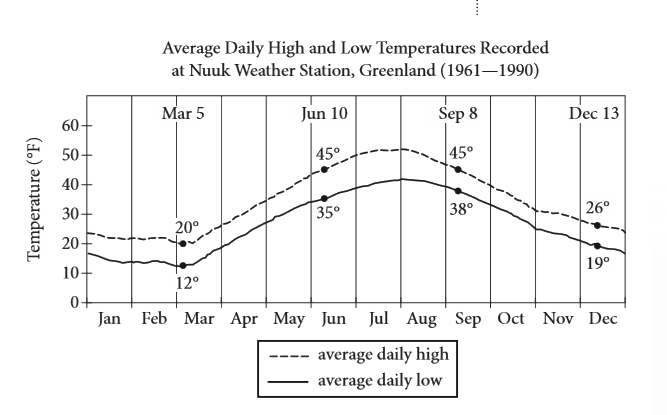
Typically, the ice sheet begins to show evidence of thawing in late (13)summer. This follows––––––––––––––––––––––– several weeks of higher temperatures. 14 For example––––––––––––––, in the summer of 2012, virtually the entire Greenland Ice Sheet underwent thawing at or near its surface by mid-July, the earliest date on record. Most scientists looking for the causes of the Great Melt of 2012 have focused exclusively on rising temperatures. The summer of 2012 was the warmest in 170 years, records show. But Jason (15) Box, an associate––––––––––––––––––– professor of geology at Ohio State believes that another factor added to the early (16) (thaw), the “dark snow” problem.
According to Box, a leading Greenland expert, tundra fires in 2012 from as far away as North America produced great amounts of soot, some (17) of it–––––drifted over Greenland in giant plumes of smoke and then (18) fell–––– as particles onto the ice sheet. Scientists have long known that soot particles facilitate melting by darkening snow and ice, limiting (19) it’s–––– ability to reflect the Sun’s rays. As Box explains, “Soot is an extremely powerful light absorber. It settles over the ice and captures the Sun’s heat.” The result is a self-reinforcing cycle. As the ice melts, the land and water under the ice become exposed, and since land and water are darker than snow, the surface absorbs even more heat, which (20) is related to the rising temperatures–––––––––––––––––––––––––––––––––––––––.
[1] Box’s research is important because the fires of 2012 may not be a one-time phenomenon. [2] According to scientists, rising Arctic temperatures are making northern latitudes greener and thus more fire prone.[3] The pattern Box observed in 2012 may repeat (21) itself again––––––––––––, with harmful effects on the Arctic ecosystem. [4] Box is currently organizing an expedition to gather this crucial information. [5] The next step for Box and his team is to travel to Greenland to perform direct sampling of the ice in order to determine just how much the soot is contributing to the melting of the ice sheet. [6] Members of the public will be able to track his team’s progress—and even help fund the expedition—through a website Box has created. (22)
View SolutionDark Snow
Most of Greenland’s interior is covered by a thick layer of ice and compressed snow known as the Greenland Ice Sheet. The size of the ice sheet fluctuates seasonally: in summer, average daily high temperatures in Greenland can rise to slightly above 50 degrees Fahrenheit, partially melting the ice, in the winter, the sheet thickens as additional snow falls, and average daily low temperatures can drop to (12) as low as 20 degrees–––––––––––––––––––––.

Typically, the ice sheet begins to show evidence of thawing in late (13)summer. This follows––––––––––––––––––––––– several weeks of higher temperatures. 14 For example––––––––––––––, in the summer of 2012, virtually the entire Greenland Ice Sheet underwent thawing at or near its surface by mid-July, the earliest date on record. Most scientists looking for the causes of the Great Melt of 2012 have focused exclusively on rising temperatures. The summer of 2012 was the warmest in 170 years, records show. But Jason (15) Box, an associate––––––––––––––––––– professor of geology at Ohio State believes that another factor added to the early (16) (thaw), the “dark snow” problem.
According to Box, a leading Greenland expert, tundra fires in 2012 from as far away as North America produced great amounts of soot, some (17) of it–––––drifted over Greenland in giant plumes of smoke and then (18) fell–––– as particles onto the ice sheet. Scientists have long known that soot particles facilitate melting by darkening snow and ice, limiting (19) it’s–––– ability to reflect the Sun’s rays. As Box explains, “Soot is an extremely powerful light absorber. It settles over the ice and captures the Sun’s heat.” The result is a self-reinforcing cycle. As the ice melts, the land and water under the ice become exposed, and since land and water are darker than snow, the surface absorbs even more heat, which (20) is related to the rising temperatures–––––––––––––––––––––––––––––––––––––––.
[1] Box’s research is important because the fires of 2012 may not be a one-time phenomenon. [2] According to scientists, rising Arctic temperatures are making northern latitudes greener and thus more fire prone.[3] The pattern Box observed in 2012 may repeat (21) itself again––––––––––––, with harmful effects on the Arctic ecosystem. [4] Box is currently organizing an expedition to gather this crucial information. [5] The next step for Box and his team is to travel to Greenland to perform direct sampling of the ice in order to determine just how much the soot is contributing to the melting of the ice sheet. [6] Members of the public will be able to track his team’s progress—and even help fund the expedition—through a website Box has created. (22)
View Solution
